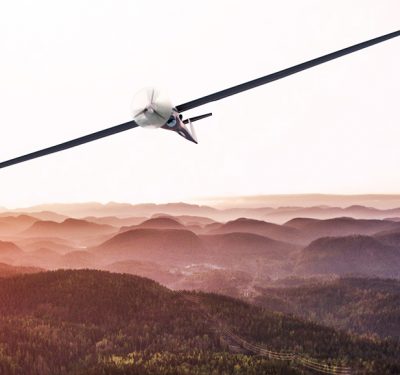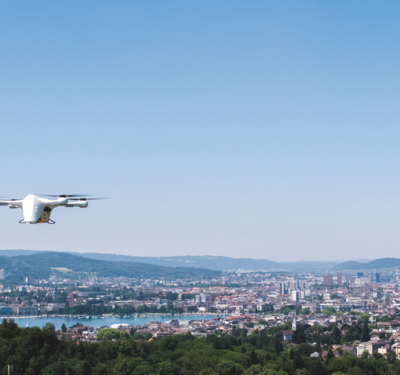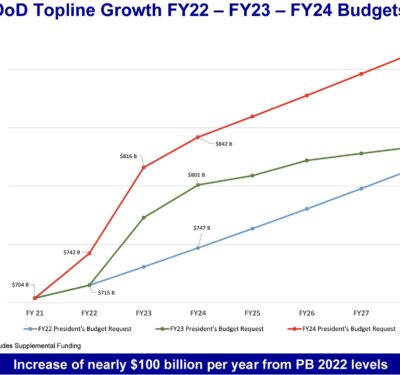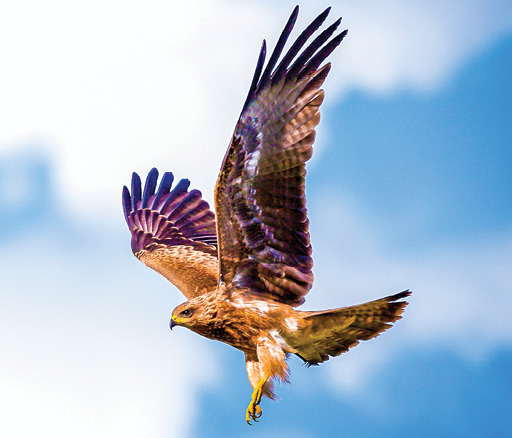
Long before aircraft took flight, birds, bats and insects conquered the skies. Now scientists are designing drones that draw inspiration from biology for advanced new capabilities.
The field of biomimicry, also known as biomimetics, seeks to emulate nature with technology. Such research is driving novel strategies to improve the safety, efficiency, dexterity and versatility of drones. It may also lead robotics to uncover biological secrets otherwise beyond the reach of scientists.
INSPIRING PROTECTIVE CAGES
Delivery drones are currently equipped with unshielded propellers, which may prove dangerous to bystanders and therefore limit the potential for in-hand parcel delivery. A possible solution is to enclose unmanned aerial vehicles (UAVs) in protective cages, but these structures face a number of tradeoffs when it comes to their designs. A cage with a dense grid of bars restricts airflow, while a sparse grid does little to protect hands from rotors. In addition, a large cage is heavy, while a small cage shortens the arms on which a drone’s propellers are placed, reducing its aerodynamic efficiency and stability.
One new biomimetic cage design is loosely inspired by the box turtle. When the quadcopter dubbed the GearQuad flies close to people, its arms and propellers retract to stay fully confined within the cage, but when flying at cruising altitudes high above people and other obstacles, its arms and propellers extend outward, increasing its aerodynamic efficiency by more than 20 percent.
“Another advantage of this design is that when the drone is not in use, you can store it in a small space,” said researcher Dario Floreano, director of the Laboratory of Intelligent Systems at the Swiss Federal Institute of Technology Lausanne. “The cage becomes the wrapping material, the box for the drone.”
To keep the cage light while still protecting bystanders, Floreano and his colleagues made GearQuad’s frame from carbon fiber beams, with the “bars” of the cage constructed of grids of plastic wires, much like the strings of a tennis racket. These wires are densely packed enough to keep out even a child’s fingers, making GearQuad safe enough to hold in one’s hand during operation, the scientists noted. In this scenario, the parcel is located on top of the drone, and the cage replaces the need for landing gear.
All in all, the components that help GearQuad extend and retract its arms from the cage weigh 169 grams, about 6 percent of the drone’s total mass, which is more than offset by the boost in lift the UAV gets from not keeping its propellers confined with the cage, the researchers said. The cage itself weighs just under six ounces (377 grams), about 15 percent of GearQuad’s total mass, a weight penalty the researchers suggested was reasonable given the added safety for people.
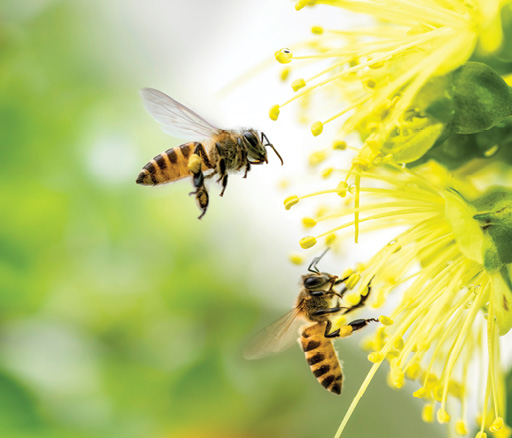
In early 2021, Floreano and his colleagues will spin off a startup company named Dronistics to commercialize GearQuad and other human-friendly drone delivery systems for what they call “last-centimeter delivery”—straight to a customer’s hands. “We’ve already raised pre-seed funding and some seed funding as well, and next year we plan on incorporating and seeking venture capital,” Floreano said.
Another creature inspiring techniques to improve drone safety is the pufferfish, which blows up like a balloon to scare away predators. Scientists at the Atlas Institute at the University of Colorado at Boulder have developed a quadcopter drone they’ve dubbed PufferBot. Based on a DJI Flame Wheel F450 frame, the robot carries a shield of plastic hoops on top of itself that can expand in size from roughly 20 inches to 33 inches in diameter in about six seconds, acting like an airbag to prevent dangerous collisions. The shield and the motor used to drive it together weigh about 3.5 pounds.
“When the frame is not needed, it can contract so the drone can go into a tight and narrow space,” researcher Hooman Hedayati said. The PufferBot team is working on making the structure as light and stiff as possible, and to boost the speed at which it expands and collapses.
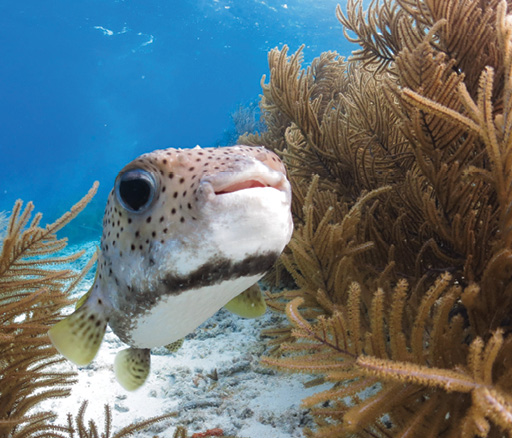
MORPHING DRONES
The maneuvering and hovering abilities of multirotor drones can help them perform sophisticated tasks. But they currently lack the ability to adapt to different flight conditions as well as birds can. That versatility could prove useful in a variety of complex scenarios, such as search and rescue missions. For example, Floreano and his colleagues—who are developing several biomimetic projects—noted that pigeons can fold their wings to optimize their gliding efficiency over a broad range of speeds, and choose different shapes for their wings to negotiate gaps of different sizes.
As such, researchers have explored morphing drones that can change shape during flight to better suit a specific task or environment. For instance, at Purdue University Xiumin Diao and his colleagues are working on a drone that can use motors to move its arms. “We got our inspiration from bees,” Diao said. “Their rotatable wings have at least three degrees of freedom.”
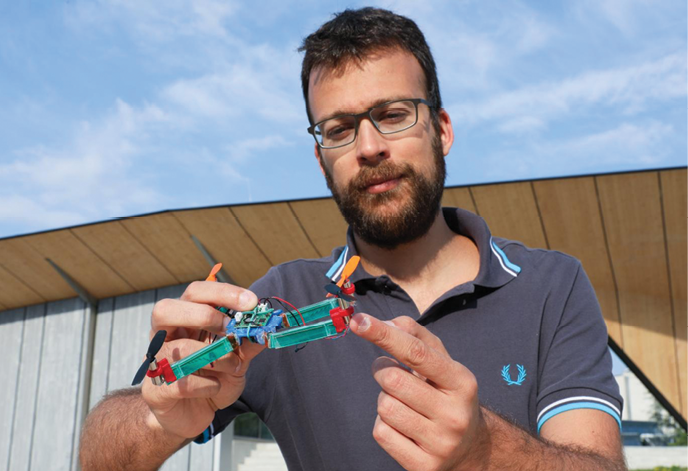
Swiss researcher Stefano Mintchev and his mini-drone. The drone’s insect-wing inspired frame can deform upon impact and return to its original shape.
Rotating the arms of a drone can alter its center of gravity, enabling more balanced thrust. In computer simulations, the researchers found such a balancing act could boost the energy efficiency of the UAV by up to 13 percent during a steady hover. Field experiments found such balancing could save even more energy—shifting the arms could help the drone keep steady in a more energy-efficient manner than constantly accelerating or decelerating the rotors to stabilize the drone. Diao worked with Purdue University to patent this drone design, and they are now looking for partners to license this technology.
Floreano and his colleagues also have worked on a drone that changes the geometry of the arms during flight. “If you want a UAV to squeeze through a very narrow space—for instance, to fly into rubble or semi-collapsed building—it can fold its arms,” Diao said. “Also, if you want to get a camera close to a surface to inspect its micro-structure, you can only do so much with zoom. So you can fold back its propellers from its front to allow its camera to come in close proximity.”
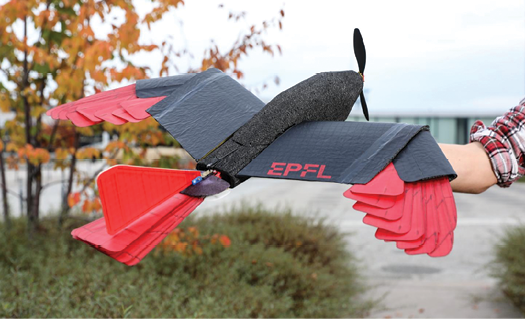
Inspired by the northern goshawk, the LisHawk possesses a morphing wing and tail with artificial feathers.
Instead of just modifying the arms of multirotor drones to make them more versatile, Floreano and his colleagues have also explored altering the entire frames of a UAV to make it more changeable. “This flexible design was inspired by the wings of wasps, which can hit obstacles like grass or sticks thousands of times without breaking,” Floreano said.
When drones collide with obstacles, the encounter can often prove catastrophic for the drones and dangerous for whatever they hit, limiting their use around people and in confined spaces, such as in buildings or forests. Instead of relying on protective cages, which add weight, Floreano and his colleagues have devised drones with flexible frames that can absorb the shock of impact and minimize damage.
The researchers developed a small quadcopter UAV with a frame made of an elastic membrane sandwiched between rigid plates. The frame is stiff enough to carry the drone’s weight and withstand the thrust of its propellers, but it softens during collisions to avoid permanent damage, snapping back into shape once past the obstacle.
“There may be indoor uses where people might see a value in these designs, since they can survive impacts without a cage and so, because of their lower weight, can have double the endurance of a drone with a cage,” Floreano said. However, “the market opportunities for these designs may not be there yet.”
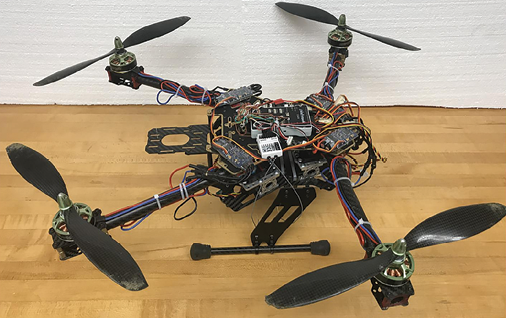
This insect-inspired drone from Purdue University can rotate its arms to alter.
BIRDLIKE WINGS
Since at least the time of Leonardo da Vinci, scientists have sought to mimic the acrobatic way in which bats and birds maneuver the sky. Increasingly, researchers are designing biologically inspired aircraft known as ornithopters that fly by flapping their wings and may one day prove more versatile, safer and quieter than existing drones.
For example, Gih-Keong Lau at the National Chiao Tung University in Taiwan and his colleagues have developed an ornithopter drone that mimics the aerobatic maneuvers of the swift, one of the world’s fastest birds. The robot weighs just under an ounce (26 grams), the equivalent of two tablespoons of flour, and can glide, hover at very low power, and stop quickly from fast speeds, all things quadcopters cannot do.
The ornithopter is also incredibly agile, turning within a one-and-a-quarter inch (32 millimeter) radius, and could recover to a stable gliding motion without tumbling after a 90-degree body flip. In addition, it consumes 40 percent less electrical power for the same level of thrust as a comparable propeller-driven robot.
“With a weight of less than 30 grams, it can fly for eight minutes,” Lau said. “In comparison, a 30-gram quadcopter can only fly four minutes. So a flapping-wing robot can be more efficient than a quad-copter, at least at small scales.”
The researchers noted their ornithopter’s light weight and slowly beating wings would make it safer for use around humans than multirotor drones. While the ornithopter could crash into humans or other obstacles in its environment and cause them little to no damage, multirotor drones spin their propeller blades at dangerously high speeds.
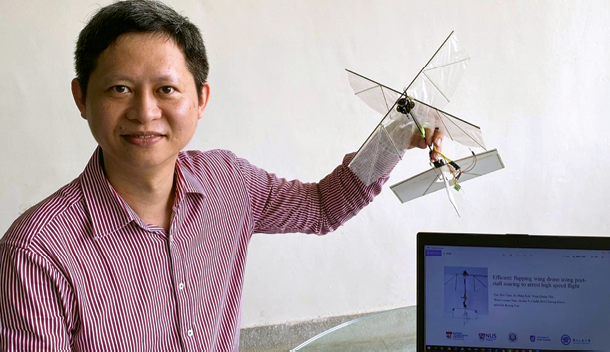
Taiwanese mechanical engineering professor Gih-Keong Lau, pic- tured with a prototype flapping wing drone.
The scientists “are now sizing up the robot so it can carry more batteries and even a camera,” Lau said. Potential applications could then include monitoring crowds and traffic, or surveying forests and wildlife. Other uses “could be inside greenhouses for pollination or pest control,” he added. “Quadcopters with their propellers spinning at very high speeds could cut into vegetation if they fly too close.”
Bird-like designs may also help winged drones fly with greater endurance and agility. For example, Floreano and his colleagues developed a robot they named LisHawk that can adjust the shape of its wing and tail to reduce air resistance when flying fast, soar slowly without falling to the ground and rapidly perform sharp mid-air maneuvers at high speeds.
LisHawk is modeled after the northern goshawk, a fast, powerful bird of prey that flies effortlessly through both dense forests and open terrain. The 10 ounce (284 gram) drone has a 3.4 foot (1.05 meter) maximum wingspan, and can change the shape of its wing and tail by spreading and tucking soft, feather-like plates on command. The robot does use a propeller for forward thrust instead of flapping wings, making its new wing and tail system potentially applicable to other winged drones and airplanes.
The advantage of winged drones over multirotor designs is that they have a longer flight time for the same weight. However, multirotors often have greater dexterity, as they can hover in place and make sharp turns. This new drone is positioned somewhere in the middle—“it can turn within a shorter space than any other winged drone,” Floreano said. “If you want to maneuver between trees or buildings and land precisely on a spot, our drone is great for that.”
LisHawk “can also fly much slower than any winged drone of the same dimensions,” Floreano said. “Flying slow is a challenge for any winged aircraft, since flying below a certain speed causes you to fall, and sometimes you want to fly slow to see things more clearly, or follow something that is slow.”
The scientists noted that increasing the morphing capabilities of drones comes at the cost of complexity in control. To take full advantage of the large number of bird-inspired wing and tail configurations, the researchers’ near-term plan is to incorporate artificial intelligence into the drone’s control system to increase its autonomy.
In the end, this bird-inspired robot may have uses besides technology. “We can use our robots as tools to validate some biological hypotheses,” Floreano said. “For example, biologists have speculated and argued that birds can achieve enormous agility because they can use their tails to allow them to fly slower. However, they have never systematically tested that with birds, because they cannot tell a bird to open its tail to fly slower. With our robot, we can do exactly that.” In other words, not only may biology end up benefiting robotics, but robotics may also end up advancing biology.


